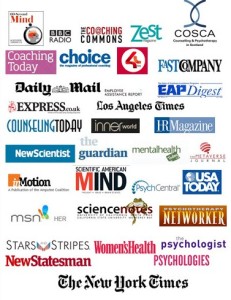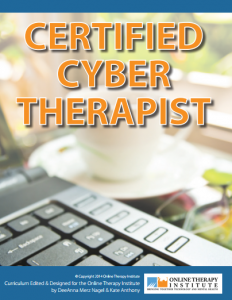The Writing Cure: Therapeutic Effectiveness via the Internet
Cathryn Heyman and Cedric Speyer
It is estimated that less than half of what we say is communicated through words, while the rest is spoken through nonverbal signals including tone, pace, inflection, body posture, facial expression, and eye contact. Since we often struggle to put our feelings into words, the majority of emotional information is communicated nonverbally. It is no wonder that many people are still sceptical when it comes to internet-based counseling. However, increasing client demand and evidence-based results point towards more use of one of the greatest mental health tools available to our mobile and widespread community – eCounseling.
eCounseling goes by many names (distance counseling, cyber-counseling, eTherapy), all of which refer to confidential communication between a counselor and a client over a secure internet connection in text-based format (including secure forms of email) or audio-visual (video chat). To ensure confidentiality, email or chat programs like Microsoft Outlook or AOL Instant Messenger are not used because the content of the ‘conversation’ can be intercepted by an internet service provider or anyone savvy enough to hack into the system. Instead, a secure webboard is used where to enter you must use a login name/password. Shepell-fgi has such a system in place. Once logged into the Shepell-fgi webboard, the correspondence takes place behind a firewall. To the person accessing services, it’s just a convenient string of exchanges in a private conference area.
Throughout the remainder of this article, eCounseling refers to this text-based format.
Fact versus Fiction
“How do you know the person writing to you is telling the truth?” You don’t know. The same can be said for in-person counseling. Counselors have to work with what the client brings to the session. While it is in the client’s best interest to be transparent, this isn’t always what happens in-person. In fact, most people have ‘stories they tell themselves’ until they feel strong or safe enough to embrace the therapeutic ‘truth’ of their life situation. In all forms of counselling, the goal is not to judge the teller or the tale, but to help the person ‘live in a bigger story’, one that gives them more perspective and freedom of choice. To this end, the ‘writing cure’ is an alternative to the ‘talking cure’ originally introduced by Freud. With the advent of email, we have come full circle back to Freud’s practice of not having any face-to-face contact with the client during therapeutic sessions or exchanges. It can free the psyche for a pure and deep form of dialogue.
Writing versus Speaking
People who do not like to write or are not able to express themselves easily in writing are not usually drawn to text-based counseling, but a lack of writing ability does not prevent a person from benefiting from eCounseling services. There are times when a person starts eCounseling and after the first exchange, discovers that the dialogue can go much deeper when they’re not ‘on the spot’. What might be lost from the immediate give-and-take of natural conversation is gained from slowing the process down so the clients have all the advantages of keeping a journal of their thoughts and feelings while still part of a healing interchange.
Crisis Situations
People who are in crisis are not candidates for eCounseling. The communication that takes place between counselor and client over the internet is asynchronous, i.e. there is a delay between responses. That means providing immediate attention for high risk situations is taken offline and handled through the S·fgi call centre.
Clinical Containment
“The eyes are the windows of the soul.” (Shakespeare)
Eye contact can be intimidating as well as comforting. When people are feeling vulnerable, they are less likely to speak their whole truth (reveal their core issue). Some self-disclosure can be withheld because it’s felt to be too personal or even shameful to reveal to another person. Yet those deeply private parts of one’s emotional life often hold the key to healing.
The ‘disinhibiting effect’ refers to the feature of eCounseling that enables people to quickly reach the heart of the matter and get ‘unstuck’ without feeling so vulnerable. With the counselor not physically present, clients feel free to openly express themselves. There is no judging by appearances or visible personality traits. A reply arrives, but it is read in the client’s own frame of reference when she or he feels ready to receive it – after the kids are put to bed and the dishes are done, for instance, no matter what the location or time zone.
Availability and Pacing
An extra layer of comfort comes from the client’s ability to ‘talk’ with the counselor whenever the time is right. And if the client thinks of something else after having sent a reply, she or he can always write an addendum and send that along. It’s safe for clients to be in control of the send button and gauge the level of their self-disclosure accordingly. The client replies to the counselor at their own pace and rate; thus, a built-in sense of containment is established. The counselor is required to respond to the client within two business days. In this way, the rhythm is set by the client, not dictated by the clinician who may only have one evening appointment available every third week, for example.
Writing Heals
Research has shown that the act of putting thoughts and feelings into written words is healing in itself. (James Pennebaker (2007) at the University of Texas describes this well) Writing allows the author to witness the experience from a safe distance, making it possible to form a new perspective. Once it’s ‘seen in print’, the author has a tangible record of the thought or feeling. When a life predicament is externalized in this way, it becomes less threatening and easier to manage. Writing it down gives the client a sense of authorship, first for how the story is told, then for what it means and finally with the counsellor’s feedback, for how it will then unfold in the next life episodes. Keeping a journal in order to grow in self-awareness has always been a time-honored practice. Now eCounseling offers a journal that answers back, containing the reflections and guidance of a trained professional.
The urge to talk with someone about a problem is really an urge to access one’s inner guidance. There’s a need to straighten out something that has you feeling tangled on the inside. The counselor’s role is to facilitate a conversation addressing the tension between ‘the inside story’ and the persona that functions in the outside world. When inside/outside aspects are aligned, they form a unified whole and feelings of security grow. You may want to visit Dr. James Pennebaker’s website and experiment with the Writing and Health exercise: http://homepage.psy.utexas.edu/homepage/Faculty/Pennebaker/Home2000/WritingandHealth.html
Conclusion
eCounseling is therapeutic communication that takes place over the internet. The written form of communication is very flexible and allows a counselor and client to ‘meet’ any time of day no matter where the two are located on the globe. There are pros and cons to this form of communication, and it does not appeal to everyone. Yet for people who do access eCounseling, it offers convenience, confidentiality, and a way to ‘compose themselves’ they can find at their fingertips.
About the authors
Cathryn Heyman is a Licensed Professional Counsellor in Austin, Texas, certified in distance counselling. As a former programming analyst and technical writer, Cathy uses technology to serve the human element in her online practice.
Cedric Speyer helped design Shepell·fgi’s groundbreaking E-counseling service based in Toronto, Canada. He supervises an E-team of 40 online counselors. Cedric champions a therapeutic approach called InnerView. Personal practices include meditation and Reiki.
Reference
J.W. Pennebaker and C.K. Chung, “Expressive Writing, Emotional Upheavals, and Health,” inHandbook of Health Psychology, ed. H. Friedman and R. Silver (New York: Oxford UP, 2007), 263-84.
http://homepage.psy.utexas.edu/HomePage/Faculty/Pennebaker/Reprints/Pennebaker&Chung_FriedmanChapter.pdf
_______________________________
This article appeared in the September 2010 Premier issue of TILT Magazine ~ Therapeutic Innovations in Light of Technology a bi-monthly magazine published by the Online Therapy Institute.
Link to original publication: http://issuu.com/onlinetherapyinstitute/docs/premier/9
SUBSCRIBE to TILT Magazine ~ Therapeutic Innovations in Light of Technology
…………………………..


